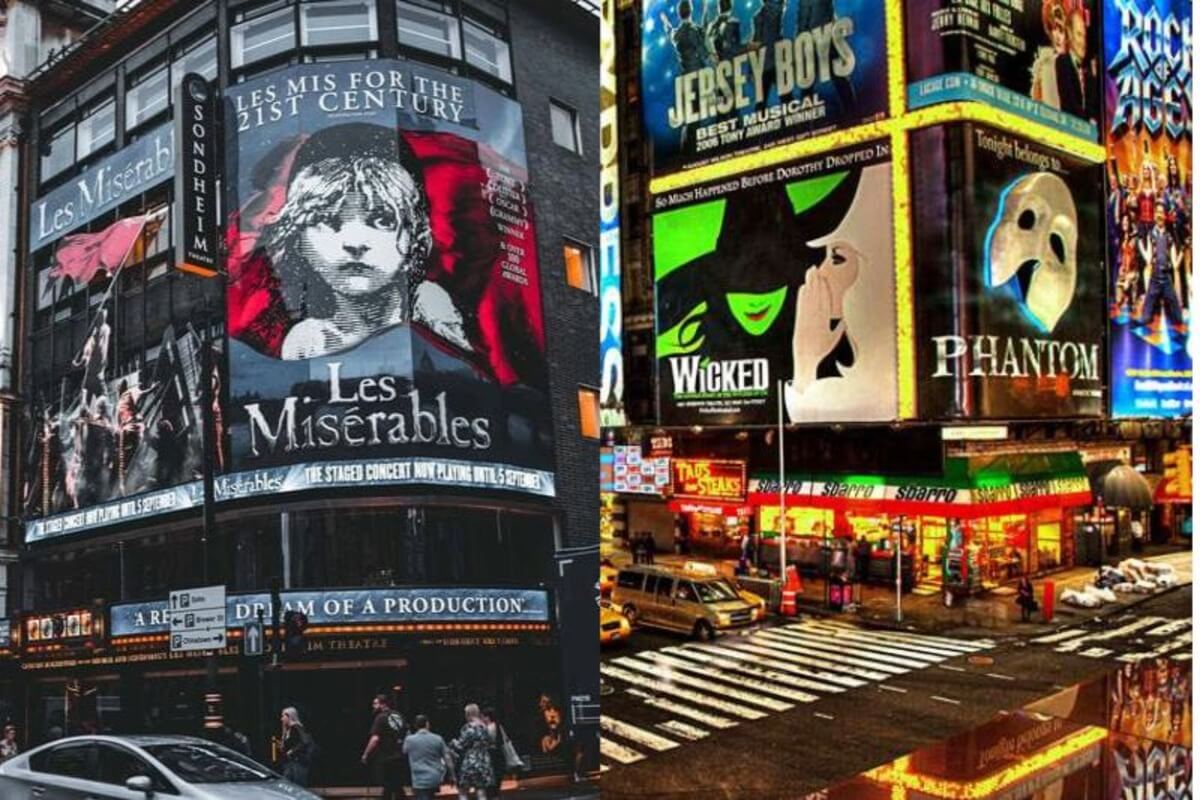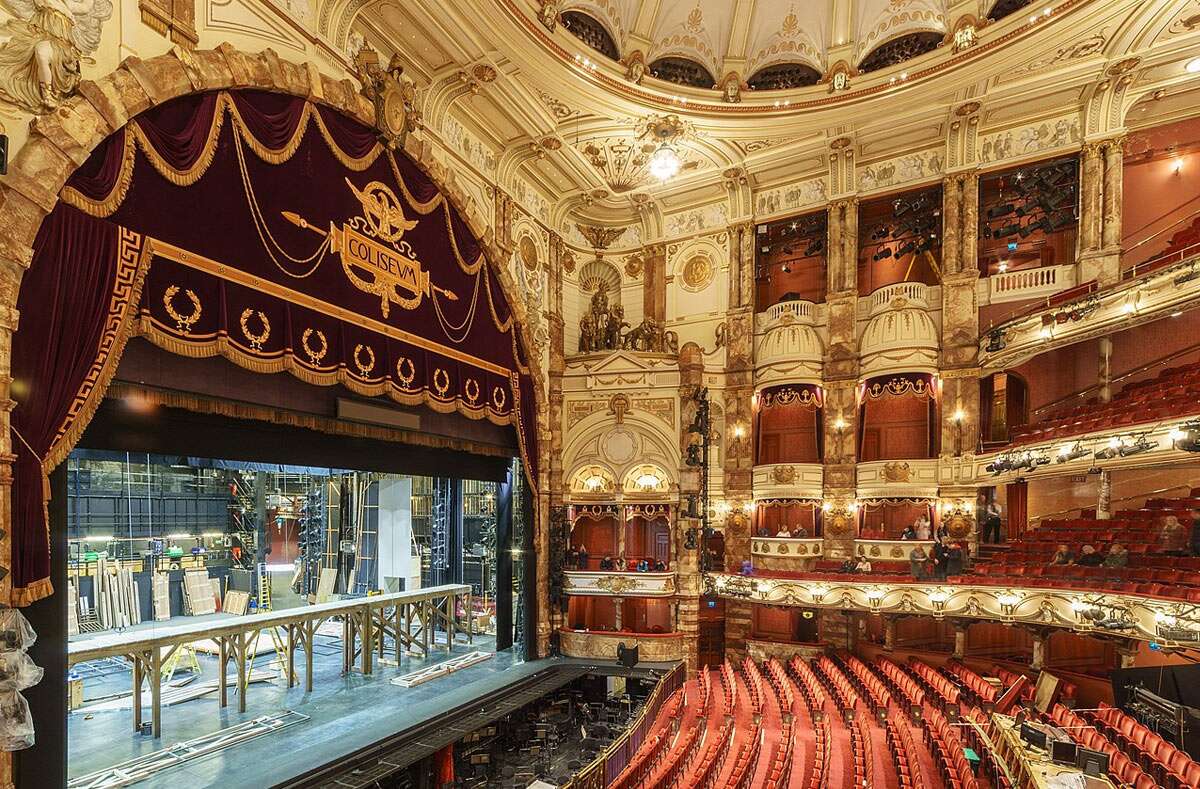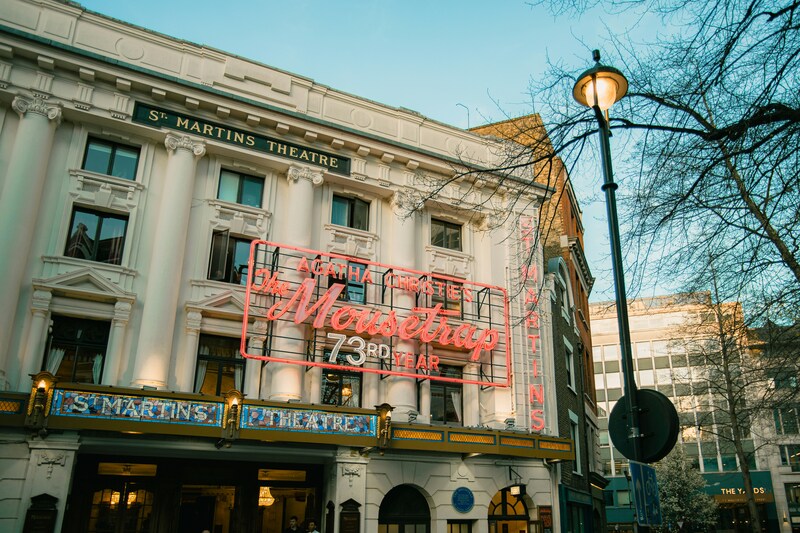West End vs Broadway - What's the Real Difference?
 Shehrazade Zafar-Arif
26 August, 2025, 10:51
Shehrazade Zafar-Arif
26 August, 2025, 10:51
London and New York: two cities steeped in art and culture, with a rich tradition of theatre. Not everyone is lucky enough to be able to see a show on both the West End and Broadway, so it makes sense to wonder: what are the similarities and differences between the two?
 Stock images of a West End theatre and Broadway.
Stock images of a West End theatre and Broadway.
Location
Both cities have clearly defined theatre districts: London’s West End is located in the west of the city, between Regent Street to the west, Kingsway to the east and The Strand to the south. New York’s Broadway spans the area between 41st and 54th Street and 6th and 8th Avenue.
While both cities have theatres outside of their respective theatrelands, the names ‘Broadway’ and ‘West End’ have inevitably become synonymous with American and British theatre. Although, thanks to Hollywood, Broadway is more ubiquitous in popular culture than the West End, and is more well-known to people living outside the UK.
The History
Unsurprisingly, London’s tradition of theatre predates New York’s, going back as far as Roman times, before really taking off during the Early Modern period, when Shakespeare and his contemporaries were putting on plays. West End theatre was born in the aftermath of the Restoration, after the Puritan ban on theatre had been lifted and London saw a boom in the arts.
Theatre in New York began in the mid 18th century, before being suspended during the Revolutionary War. In the mid 19th century, as the city expanded, the theatres moved from Downtown to Midtown Manhattan, then a seedy and rundown area overrun by peep shows and adult cinemas.
Interestingly, both the neighbourhoods which would one day become Broadway and the West End were originally deeply impoverished parts of the cities, chosen for their abundance of space and cheap real estate. It’s hard to imagine, since they now make up some of the most expensive neighbourhoods in New York and London.
Fun Fact: The Theatre Royal Drury Lane is the oldest theatre on the West End, having been around since the 1660s, while the oldest Broadway venue, the Lyceum, was only built in 1903. So some West End theatres are even older than the United States itself!
 The London Coliseum
The London Coliseum
The Theatres
Most of the West End’s theatres were built in the Victorian or Edwardian eras, which is reflected in their grand architecture and lavishly beautiful interiors. But these older buildings tend to be smaller in terms of staging space, and sometimes have cramped seats with less legroom, while their age and relevance as historical buildings mean it’s tricky to refurbish them. New York’s theatres, meanwhile, are housed in bigger, more modern buildings, with more room for seating as well as backstage, making it easier to stage shows with large set pieces. On the flip side, however, Broadway has less theatres than the West End, which means venues are more expensive to hire.
While the layout of the theatres is largely the same, the nomenclature of their seating plans differs slightly. What we would call the stalls in the West End are known as the orchestra seats on Broadway, and what we’d call the circle is the mezzanine. Most Broadway venues don’t tend to have a second balcony or upper circle.
Fun Fact: On Broadway, the largest theatre is the Gershwin Theatre, with 1933 seats, with the smallest being the 597-seat Hayes Theatre. In the West End, the London Palladium has the biggest capacity, with 2286 seats, while the Fortune Theatre is the smallest with 432 seats.
Pricing
Broadway tickets are significantly more expensive than West End tickets - unsurprising again, since New York as a city is more expensive than London, but also because of higher production costs and a more unionised workforce, compared to London’s more publicly subsidised theatre.
The Audiences
It may sound like a bit of a stereotype to say that British theatre audiences are more reserved than their American counterparts. But American theatre-goers are more likely to laugh, applaud, or cheer when a famous actor enters the stage, while British audiences tend to reserve their applause for the end of a scene or musical number. They’re also less likely to give a standing ovation unless they’re really impressed with the show.
Fun Fact: At every Broadway show, you get a free playbill with all the information about the play and cast. In the West End, we call this a programme, and it’s something that needs to be purchased.
The Shows
Broadway tends to be more commercially minded than the West End, with a focus on building large-scale, spectacular shows that aim above all to entertain, and emphasising star power by hiring more big-name actors. The West End is more open to experimental works among the classic, sell-out shows, and often boasts a broader range in its productions. You’re more likely to see creative risks and artistic innovation on a West End stage, and more likely to experience lavish, visually impressive sets and high-energy special effects on Broadway. Higher ticket prices also mean Broadway has the money to create more expensive shows with high production value.
Fun Fact: The longest-running play on the West End is The Mousetrap, which opened in 1952, and the longest-running musical is Les Misérables, which has been playing since 1985. On Broadway, the longest-running show was The Phantom of the Opera, which finally closed in 2023 after 35 years. The title is now held by Chicago, which opened in 1996.
 The Mousetrap at St Martins Theatre. Photo by Jackson Sears on Unsplash.
The Mousetrap at St Martins Theatre. Photo by Jackson Sears on Unsplash.
So which one is better?
Ask a New Yorker and they’ll tell you confidently that it’s Broadway. Ask a Londoner and they’ll just as vehemently insist it’s the West End. Good theatre is often subjective and comes down to a question of personal taste, and it’s often a product of the city and country in which it’s been created. While most shows transferring from Broadway to the West End, or vice versa, remain virtually the same, there are occasionally a few minor tweaks in language or slang to tailor them to their new audience, because different audiences appreciate and expect different things.
But the good news is that popular, well-loved shows almost always transfer over from one side of the pond to the other, which means these two theatre-loving sister cities are constantly in conversation with and connected to each other.
Latest News

 Rehearsal footage released for UK premiere of DANIEL'S HUSBAND
1 December 2025 at 16:18
Rehearsal footage released for UK premiere of DANIEL'S HUSBAND
1 December 2025 at 16:18

 Full cast announced for revival of AMERICAN PSYCHO at Almeida Theatre
1 December 2025 at 14:55
Full cast announced for revival of AMERICAN PSYCHO at Almeida Theatre
1 December 2025 at 14:55

 Review: EMERALD STORM at Emerald Theatre
1 December 2025 at 14:36
Review: EMERALD STORM at Emerald Theatre
1 December 2025 at 14:36

 Review Round-Up: PADDINGTON THE MUSICAL at the Savoy Theatre
1 December 2025 at 13:26
Review Round-Up: PADDINGTON THE MUSICAL at the Savoy Theatre
1 December 2025 at 13:26